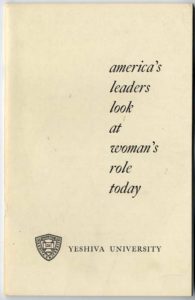Jun 12, 2018 By: rolen
On May 9, 1958, Mayor Robert F. Wagner proclaimed “Stern College Month,” a month of celebration in honor of the first commencement of Stern College for Women.
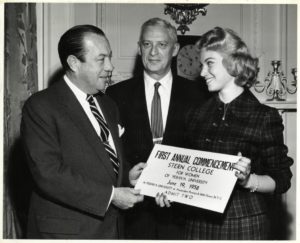 Mayor Robert F. Wagner, Max Stern, Shirley Pasternak
Mayor Robert F. Wagner, Max Stern, Shirley Pasternak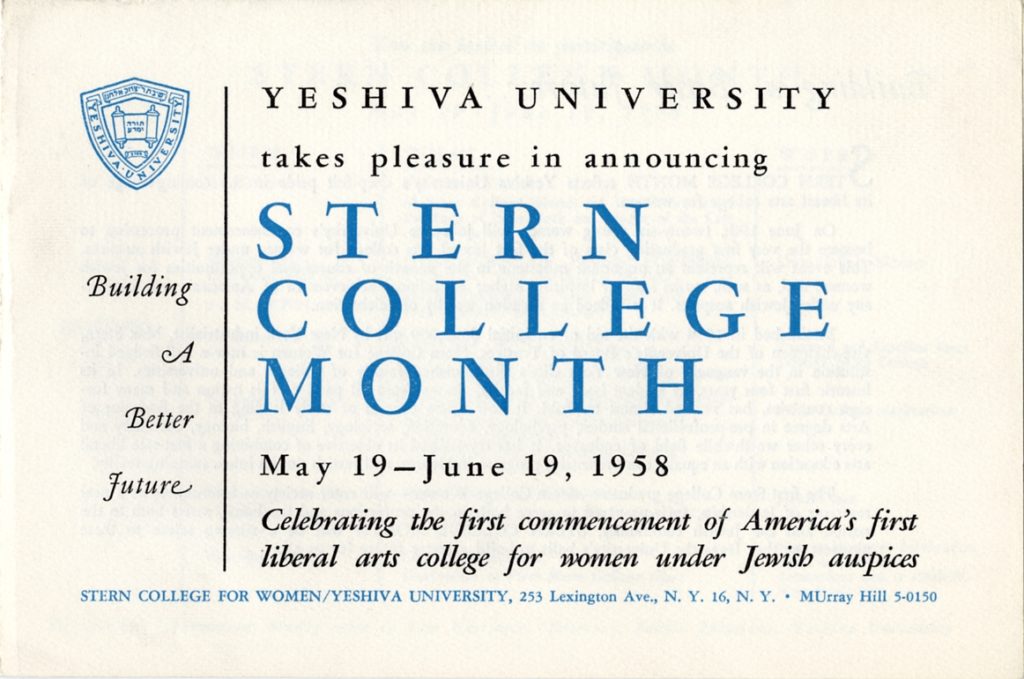 The announcement inaugurated a month-long series of events leading up to commencement day on June 19, 1958. A flyer for the events portrayed the graduates as “Building a Better Future . . . The first Stern College graduates – Stern College Women – will enter society as forerunners of a new reservoir of leadership, fully-prepared to serve both in the professions and the home, assets both to the nation and the Jewish community. STERN COLLEGE MONTH will be a stirring salute to these pioneers, as they leave the University’s halls to build a better future for us all.”
One of the highlight of the month was Eleanor Roosevelt’s fireside chat with the women of Stern College on May 22, 1958.
The announcement inaugurated a month-long series of events leading up to commencement day on June 19, 1958. A flyer for the events portrayed the graduates as “Building a Better Future . . . The first Stern College graduates – Stern College Women – will enter society as forerunners of a new reservoir of leadership, fully-prepared to serve both in the professions and the home, assets both to the nation and the Jewish community. STERN COLLEGE MONTH will be a stirring salute to these pioneers, as they leave the University’s halls to build a better future for us all.”
One of the highlight of the month was Eleanor Roosevelt’s fireside chat with the women of Stern College on May 22, 1958.
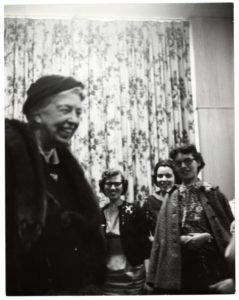 Eleanor Roosevelt at Stern College
Eleanor Roosevelt at Stern College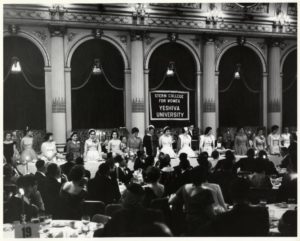 Dinner honoring Max Stern and the first Stern College graduating class, June 18, 1958
Dinner honoring Max Stern and the first Stern College graduating class, June 18, 1958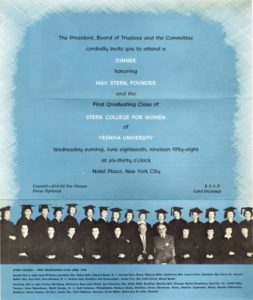 Max Stern was a towering figure in Jewish education in America. Stern, born in Germany, came to the United States in 1926 and started Hartz, a pet food company. He also became involved in Jewish education and philanthropy. A profile on Stern in the New York Post (December 16, 1964) quoted him: “’I always believed,’ he said, ‘that education, in particular religious education, is the only way to build a better world and an everlasting peace.’” Stern acted on his beliefs; he was president of the Hebrew Teachers Training School for Girls, founded by the Union of Orthodox Jewish Congregations in 1926; he presided over its transformation into the Teachers Institute for Women and its merger with Yeshiva University in 1952. As Vice-Chairman of the University’s board of trustees, he donated $500,000 in 1954 to establish Stern College for Women, named in memory of his parents, Emanuel and Caroline Stern. The gift helped purchase the 1911 building of the former Packard Commercial School, on Lexington Avenue and 35th Street in Manhattan, for the new college.
Max Stern was a towering figure in Jewish education in America. Stern, born in Germany, came to the United States in 1926 and started Hartz, a pet food company. He also became involved in Jewish education and philanthropy. A profile on Stern in the New York Post (December 16, 1964) quoted him: “’I always believed,’ he said, ‘that education, in particular religious education, is the only way to build a better world and an everlasting peace.’” Stern acted on his beliefs; he was president of the Hebrew Teachers Training School for Girls, founded by the Union of Orthodox Jewish Congregations in 1926; he presided over its transformation into the Teachers Institute for Women and its merger with Yeshiva University in 1952. As Vice-Chairman of the University’s board of trustees, he donated $500,000 in 1954 to establish Stern College for Women, named in memory of his parents, Emanuel and Caroline Stern. The gift helped purchase the 1911 building of the former Packard Commercial School, on Lexington Avenue and 35th Street in Manhattan, for the new college.
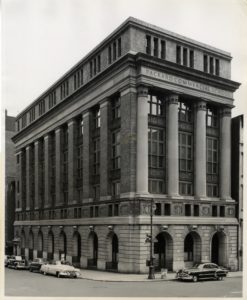 Packard Commercial School Building, Stern College's first building
Packard Commercial School Building, Stern College's first building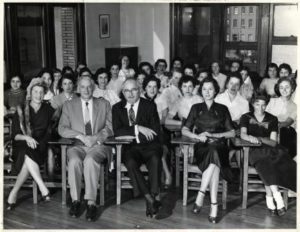 Stern College Welcoming Assembly, September 13, 1954
Stern College Welcoming Assembly, September 13, 1954Seated L-R: Ghity and Max Stern, Samuel Belkin, Cecile Feder, Gloria Stern
The primary interest of Stern College for Women is to provide young women with an education in liberal arts and science and at the same time a rich grounding in Jewish learning and traditions. With a curriculum emphasizing the importance of the humanities, the program of the College is designed to meet realistically the goals of today’s young woman for intelligent citizenship, cultural appreciation, preparation for a career and graduate study, and management of a Jewish home and family. The academic programs lead to the degrees of Bachelor of Arts (B.A.) or Bachelor of Religious Education (B.R.E.). To those who can qualify, a Hebrew Teacher’s Diploma may be granted.Dr. Belkin’s message to the students in the 1957 freshman class journal, In Retrospect, explained his view of the College to the students who were on the road to graduation: “The Stern College graduate – a dynamic professional woman whose attitudes and efforts are characterized by the rich and lasting values of both the contemporary culture and Judaism – will begin to make her unique contributions to society.” Dr. Belkin’s letter to the students in the 1959 issue of the Stern yearbook, Kochaviah, expanded on his vision for the school, then in its fifth year:
The Jewish woman throughout history has contributed immeasurably to the welfare of our people. Traditionally, she has been the first teacher of our youth, introducing them to the vast treasures of Jewish culture. Hers has been the responsibility of imbuing the home with the spirit of Godliness that is the sole foundation for a truly moral life. Because of her immense influence for good, the home has been characterized as a major sanctuary of our faith. Thus the Jewish woman has made possible the continuation of our sacred heritage down through the ages. With the coming of modern times, a new dimension of experience was added to the life of the Jewish woman. Now she could play a vital role in the general community, utilizing her special insights in an ever-widening area of activities. Law, medicine, the physical sciences . . . these and many other fields offered her untold opportunities for personal fulfillment and professional advancement. This occurrence brought the need for a special kind of education. Neither the religious training alone, usually acquired in the home, nor the usual general schooling could adequately prepare the Jewish woman for her new position. Rather, a unique harmonizing of the two was required. It was to make available this new kind of education that Stern College was established. Here the arts and sciences of the western world are perpetuated together with the time-honored practices and teachings of Judaism. Here the modern woman can devote herself to the complete development of her capabilities as a Jewess and as a student of western culture. You who have benefited from this comprehensive training bear the obligation of carrying on the traditions of Torah even as you enter into your various chosen profession. I trust that you will meet this challenge with distinction, dedicating yourselves to a lifetime of service to the Jewish community and all humanity.The articles in “America’s Leaders Look at Woman’s Role Today,” the booklet distributed at the Stern College 1958 dinner, addressed women’s education and role in the modern world. The publication was the brainchild of Sam Hartstein, director of public relations at the University and editor of the compilation together with Albert W. Landa. No religious figures at the University weighed in on the topic. Hartstein and Landa portrayed the College and addressed the question of women’s issues in their introduction to the publication: “Stern College for Women, the first liberal arts college for women under Jewish auspices, represents a trailblazing development, affording Jewish women their first opportunity to prepare for careers in the great professions through pursuit of the liberal arts and sciences, while simultaneously strengthening their spiritual and cultural background. It is a dual training ground which enables Jewish women to assume leadership both in the home and community.” The questions of the hour for American women were: “But just how far has the American woman come? How has her ‘emancipation’ affected our way of life? What future is in store for her as we enter the space age? These are questions still to be answered as this unprecedented social revolution continues at a brisk pace.” Hartstein solicited and received contributions on the issues from a variety of American and Jewish leaders: President Dwight D. Eisenhower; Senator Jacob K. Javits; Senator Margaret Chase Smith; Dr. Persia Campbell, Consumer Counsel to the Governor of New York State; Mrs. Franklin D. Roosevelt; Dorothy Schiff, Publisher of the New York Post; Mrs. Moise S. Cahn, National President of the National Council of Jewish Women; Mrs. Meyer Karlin, President of Hapoel Hamizrachi Women; and Mrs. Allen I. Edles, President of the Women’s Branch, Union of Orthodox Jewish Congregations of America, whose article was entitled: “American Jewish Woman of Tomorrow.” Neither Dr. Belkin nor the authors in “America’s Leaders Look at Woman’s Role Today” addressed a role for women in Judaism or Jewish life other than in the home, as teachers - presumably elementary or high school - or as Jewish communal workers or volunteers. The importance of the role of women and mothers in raising and educating Jewish children was depicted as a time-honored exalted position, a role of utmost importance; Judaism had never kept women back; it was the outside world which had limited their horizons, and the modern innovation of the 1950s was that now the great-wide world finally offered professional training and new vistas and opportunities for women. How women and families would integrate and combine the two was one of the questions of the day, and a dilemma the Stern College women raised with Mrs. Roosevelt during the fireside chat. Mrs. Roosevelt’s opinion was that it was a joint venture; if there was complete cooperation and agreement between the couple, and the situation was well thought out, women could successfully work outside the home and raise a family; it could be to the benefit of the parents and the children. The curriculum of Stern College, both in secular and Judaic studies, has evolved over the years and so have high-level professional possibilities for women in the Jewish professional world, as well as the world at large. A milestone of note in Jewish education for women was Rabbi Joseph B. Soloveitchik’s Talmud lecture at Stern College in 1977, which inaugurated the Beit Midrash program. The flyer for the opening of the Beit Midrash program in 1977 noted that “while the study of Talmud has long been an option in its course offerings, with the initiation of the Beit Midrash Program Stern College for Women has revitalized its Judaic studies curricula. The Beit Midrash Program is unique in several ways. It changes the intensity and format of women’s learning through its use of the traditional combination of shiurim (lectures) and its individualized group method of study (chavruta). …It is the only program of its kind in the United states designed to allow women who have learned intensively in Israel or in a yeshiva high school to continue their studies on an equally comprehensive and advanced level.”
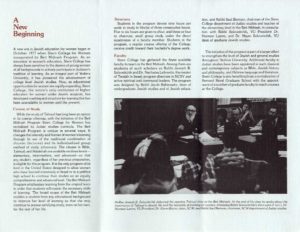 A review of school brochures and catalogs illuminate the statement that Talmud study “has long been an option.” In the 1940s, the Hebrew Teachers Training School for Girls brochure listed Rabbi Solomon Wind as an instructor in Bible and Talmud. In 1955 through 1957, Stern College offered courses called “Talmudic Literature I-IV;” in the 1960s through the early 1970s a student could study “Talmud: Advanced Selections from Seder Nezikin” and selections from tractates Nashim and Moed. In the 1970s, Stern course catalogs list: “Introduction to Talmudic Literature,” “Development of Jewish Law (Talmud),” and “Talmud 2” taught by Dr. [Isaac] Suna and Rabbi [Melech] Schachter. Talmud study at Stern has grown – albeit in fits and starts - since the introduction of the Beit Midrash program in 1977; for more information on Rav Soloveitchik’s shiur and the Talmud program post 1977 at Stern College, see the articles in Lehrhaus by Rabbi Saul Berman and Rabbi Dr. Zev Eleff, as well as responses to the articles.
Today Talmud studies flourish: in 2000 Stern College introduced the Graduate Program in Advanced Talmudic Studies (GPATS), a two-year master's degree program and for women in biblical and Talmudic interpretation. Thus the daughters of the class of ’58 had the opportunity to study in the Beit Midrash in 1977, and their daughters and granddaughters can study Talmud at an advanced level in Stern and at GPATS.
A review of school brochures and catalogs illuminate the statement that Talmud study “has long been an option.” In the 1940s, the Hebrew Teachers Training School for Girls brochure listed Rabbi Solomon Wind as an instructor in Bible and Talmud. In 1955 through 1957, Stern College offered courses called “Talmudic Literature I-IV;” in the 1960s through the early 1970s a student could study “Talmud: Advanced Selections from Seder Nezikin” and selections from tractates Nashim and Moed. In the 1970s, Stern course catalogs list: “Introduction to Talmudic Literature,” “Development of Jewish Law (Talmud),” and “Talmud 2” taught by Dr. [Isaac] Suna and Rabbi [Melech] Schachter. Talmud study at Stern has grown – albeit in fits and starts - since the introduction of the Beit Midrash program in 1977; for more information on Rav Soloveitchik’s shiur and the Talmud program post 1977 at Stern College, see the articles in Lehrhaus by Rabbi Saul Berman and Rabbi Dr. Zev Eleff, as well as responses to the articles.
Today Talmud studies flourish: in 2000 Stern College introduced the Graduate Program in Advanced Talmudic Studies (GPATS), a two-year master's degree program and for women in biblical and Talmudic interpretation. Thus the daughters of the class of ’58 had the opportunity to study in the Beit Midrash in 1977, and their daughters and granddaughters can study Talmud at an advanced level in Stern and at GPATS.
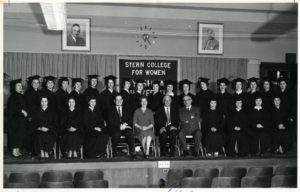 First graduating class of Stern College, 1958
First graduating class of Stern College, 1958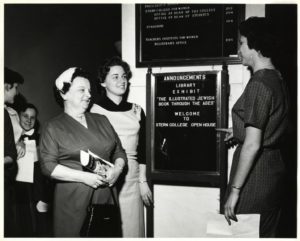 Open House, December 1958
Open House, December 1958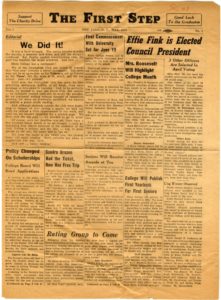
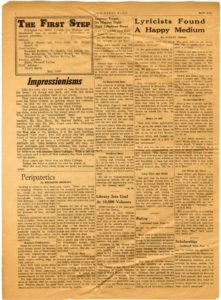
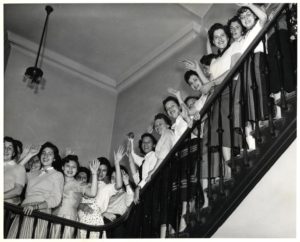 Stern College entering class, 1954
Stern College entering class, 1954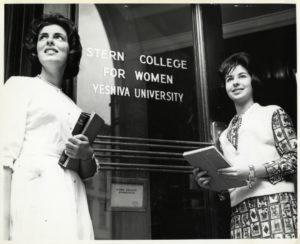 Stern students, Kitzur Shulhan Arukh in hand, near a small sign "Stern College Synagogue, Sabbath Services, 9 AM"
Stern students, Kitzur Shulhan Arukh in hand, near a small sign "Stern College Synagogue, Sabbath Services, 9 AM"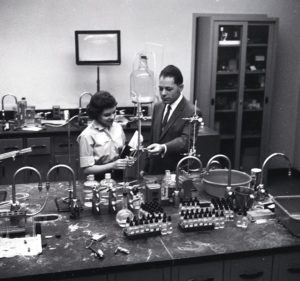 Open house, 1959
Open house, 1959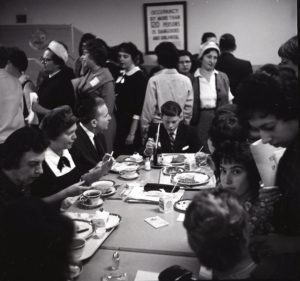 Open House, 1959
Open House, 1959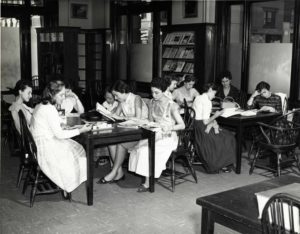 In the library
In the library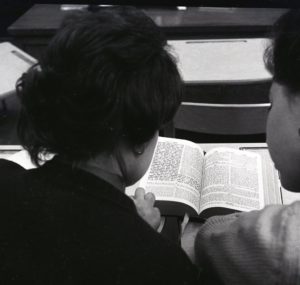 Studying Humash - Bible class
Studying Humash - Bible class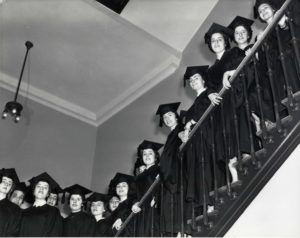 Stern College Class of '58 in caps and gowns
Stern College Class of '58 in caps and gowns
